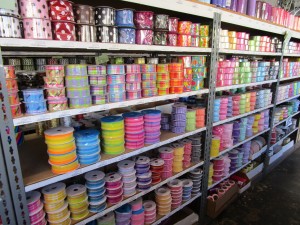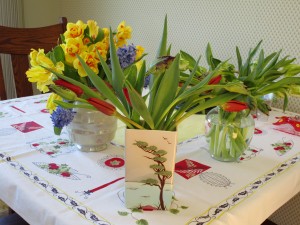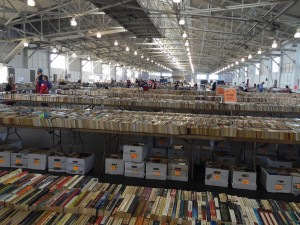Her by Harriet Lane
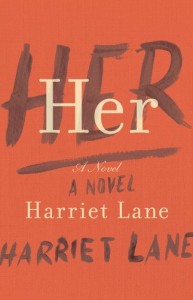 You may remember my review of Harriet Lane’s previous novel Alys Always.
You may remember my review of Harriet Lane’s previous novel Alys Always.
I greatly admire Ms. Lane’s spare and visual writing style –she’s a writer who can paint so much in so few words.
Her is her second novel and like Alys Always it’s creepy minimalist writing at its best.
Told in the first-person narrative from two women’s perspectives, the novel teases you along in alternating chapters.
Nina spots Emma in North London — a woman she knows from her childhood and contrives a way to connect with Emma — we know not why.
Emma is a harried, scattered mother of two kids. She is also vulnerable and clueless – she doesn’t remember Nina and takes her to be a new friend. You cringe as Nina (obviously a psychopath) begins to orchestrate a series of devious and manipulative events to successfully insinuate herself into Emma’s life.
Emma’s messy, but ordinary domestic life is the perfect stage for Nina to play out her menacing plan. True friends – maybe not. Nina purposely messes with Emma — household items go missing, babysitting plans go awry, a child seems to get temporarily lost — these haphazard domestic incidents provide a ominous backdrop. The reader knows this is a household about to unravel in a most disturbing way.
And so we are intrigued…what’s going to happen? Why is Nina so intent on connecting with Emma? What was the past incident that is causing this evil charade?
As in her previous novel, Ms. Lane is very good at painting the seemingly normal, but creepy stalker. Slightly “off” people who seamlessly infiltrate themselves into innocent lives. You read along, nervously aware that something terrible is going to come of all this, but unsure what, how or why. That is the mark of an intelligently constructed thriller.
This book has been compared to the currently popular thrillers Gone Girl and Girl on a Train. I’ve read both books and Her is far superior writing and I think more thrilling and creepy. Again, it’s the minimalist writing – an around-the-campfire ghost story teller who pauses for utmost effect to let your imagination fill in around the silence.
My only quibble is with the reiteration of the same event from each woman’s point of view — there isn’t enough difference in the two voices to make the re-telling fresh and so at times the narrative seems to slow down – but perhaps this is Ms. Lane’s intention – maybe it’s supposed to be a slow burn.
Stick with it my friends, the author kicks up the tension and the last chapters are evil and frightening. To some, the ending may feel unfinished and you may be wondering WHY? — but that is the chilling nightmare.
The Life-Changing Magic of Tidying Up by Marie Kondo
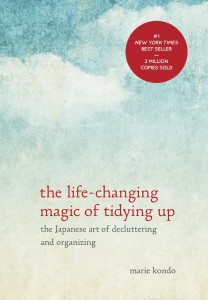 While reading this book, I kept thinking of my sister. From a very young age, she loved organizing and keeping things in order. Her room was always neat as a pin with everything in its place. She would put away the toys while we were still playing with them and loved organizing anything – mom’s kitchen drawers, my jewelery box…anything slightly messy was at risk of little sister putting it in order.
While reading this book, I kept thinking of my sister. From a very young age, she loved organizing and keeping things in order. Her room was always neat as a pin with everything in its place. She would put away the toys while we were still playing with them and loved organizing anything – mom’s kitchen drawers, my jewelery box…anything slightly messy was at risk of little sister putting it in order.
It’s no wonder I was reminded of my sister — Marie Kondo also grew up wanting to organize and tidy things – from her classroom, to her siblings rooms to her parents kitchen and has turned this lifelong passion (obsession?) into a phenomenon in Japan.
The Life-Changing Magic of Tidying Up is a small book – purposely designed to take up very little space. It has a calming clouds and sky image on the cover and easy to hold it in your hands. From the beginning I really warmed to the word “tidy” – such a sweet, old-fashioned word, which seems gentler and more approachable than many other guides and television shows focused on getting organized or how to clean out your awful hoarding mess things. This book is translated from Japanese, so some of the writing is a bit clunky, but nonetheless, I gathered some new ideas, and shook my head at others, while making my way through this book.
She divides people who can’t stay tidy into three types: “Can’t throw it away”, “Can’t put it back”, and “first two combined.” Well, that rang true right off the bat. Ms. Kondo goes on to bust the usual practice of cleaning one closet or one drawer at a time. She advocates cleaning out things (not spaces) in a certain order – and not putting anything back until you’ve finished the process of discarding. This may be practical in tiny Japanese homes, but I wonder how it would work for the multi-storied, many-roomed homes of America. For example, Ms. Kondo wants you to take every single piece of clothing in your home and place it on the floor – the mere thought gave me an instant headache. But it appears that’s the goal — to overwhelm her clients with the staggering amount of clothing they posses and seldom (or never) wear. As a person who changes sizes with regularity (I have three sets of clothes: fit me now, maybe fit me soon, and in my dreams…) this is a very scary proposition.
Storage solutions (sorry Container Store) are poo-pooed as just a method to perpetuate hoarding. OK that does make sense but Ms. Kondo goes too far when keeping a spare button box is discouraged because when a button falls off it is usually time to get rid of the clothing? The question mark is mine. Should we also not keep a sewing box to make repairs?
When it comes to childhood memorabilia and other things from the past – Ms. Kondo makes good sense with this advice; “It is not our memories but the person we have become because of those past experiences that we should treasure. This is the lesson these keepsakes teach us when we sort them. The space in which we live should be for the person we are becoming now, not for the person we were in the past.” Whoa — I had to write that down.
This book does point out that mess is often about unhappiness and that tidying can bring happiness – OK that, too is true. I always feel better when I’ve cleared out a drawer or a closet. But I’m not sure it’s linked to the spirituality that Ms. Kondo promises. This little volume is packed with some pretty “out-there” suggestions – greet your home when you enter it. Say thank you to items before you put them away. Folding clothes with an open palm transmits positive energy. Do my clothes really need energy of any sort?
Stockpiling is obviously discouraged (sorry Costco, Sam’s Club) and once again I thought of my sister – when she uses one can of tomato sauce, she replaces it with one can of tomato sauce. No impulsive buy 3 get one free sales for her. Even though my house is tiny, I have a pantry. I live in fear of running out of chicken broth. I just looked and currently have three cartons.
The book advocates only keeping things that truly give you joy – which I understand, but what about my the pragmatic things in your life? My food processor is ugly, it takes up space in my cupboard and it doesn’t actually bring me said “joy” –but when I need it – wow is it practical. Ms. Kondo lost me with her advice on clearing out books (natch), She advocates taking each book off the shelf and deciding if the book in your hands brings you joy before deciding whether to keep it. She feels books left on the shelves have a certain inertia and tend to stay there. Has she never wanted something to read, not sure what, and found the perfect book on your own shelf…now that’s joy.
I fear her OCD (she empties her purse every single night, placing each of the contents in its own little place, and puts her watch into a little box every night so it can “rest” overnight) — seeps into her advice, loosing credibility for the real world and the rest of us. I agree with other reviewers that the book only talks of throwing things away rather than donating, recycling or selling items you’re discarding. Does Japan have a bottomless landfill?
I shook my head over the impracticality of much of her advice. Ms. Kondo is obviously a single woman and able to keep everything she owns exactly in place …obviously she doesn’t live with messy children or a “I’ll find a use for this someday” husband. Her business is thriving in Japan and this book is a best-seller…but I must admit I only got a few good pointers from the book and overall I found it preachy and overly-simplistic. So do as I did – get this book from your library – gather what you will from reading it – and then return to your library — no need to add this book to your clutter.
A Flower Market Birthday
So my birthday was a few days ago and for several years now, at a loss for what to get me (I have everything I could ever want) my adorable husband takes me to the San Francisco Flower Market.
I go crazy buying flowers and he patiently pays for everything and follows me along holding my purchases. We then go out to breakfast and once home, I happily arrange my flowers and place vases throughout the house.
The best birthday gift ever.
A treat for the eyes and the nose.
Promise me, you’ll click the photos to see the floral display in its full glory.
I wander from nursery stall to stall …the place is huge, nonetheless stalwart husband carries my spoils.
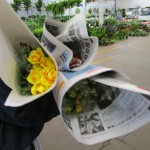

Such choices – such temptation…
There’s a floral supply stall with amazing ribbon choices.
But, in the end, I have three lovely bouquets at home. Tulips are not yet opened – but had to show you anyway.
So here’s a question – what luxuries would you give yourself if you were very wealthy?
For me it would be fresh flowers in the house year round…and I’m lucky because with my garden, I am able to have them most all of spring and summer.
And while we’re fantasizing about luxuries – I would also require fresh towels and sheets every day.*
Maybe I belong in a hotel?
* Of course, not with our current drought – fantasy only.
The Book Tingle
 Just on the heels of my gushing post on Nora Ephron and her marvelous essay On Rapture…comes this.
Just on the heels of my gushing post on Nora Ephron and her marvelous essay On Rapture…comes this.
Stop whatever you are doing and go to one of my favorite book blogs — HERE Savidge Reads.
He talks about “The Book Tingle” and to quote Mr. Savidge:
There is an almost unexplainable feeling from the start which lasts until the final full stop. Not for a single moment does the book let you down, or indeed out of its grasp, you are effectively spell bound by it. It feels like all the rest of the world goes completely out of your mind and all that is left is you, the book and the author’s words. It is the prose, the characters, the atmosphere, everything! You almost feel, without it sounding arrogant, that this book was written just for you.
Isn’t that wonderful? Doesn’t it just speak to any book lover? Can you blame me that I have a big old book crush on Mr. Savidge.
Got me thinking about my “Tingle” worthy books:
The Shadow of the Wind, The Magician’s Assistant, A Fine Balance, anything by Kate Morton, Prodigal Summer, The Amazing Adventures of Kavalier & Clay, The Thirteenth Tale, The Piano Tuner, Cutting for Stone, Gone with the Wind, and I’m with Savidge – Rebecca.
I’m sure I’m skipping many but in the meantime …
What are your “Tingle” books?
The Most of Nora Ephron
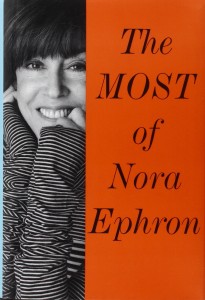 From The New York Times Book Review “Nora Ephron was the person everybody wanted to hang out with, in part because she was funny and charming but more critically because she made the people she was with feel funny and charming . . . She was the one who listened and then finally tossed in the one fabulous line that brought everything together. Her best writing was exactly the same . . . It takes a particular combination of winning voice and brutal candor, of intimacy and objectivity, to turn what happens to you into a story that means something to the wider world . . . The Most of Nora Ephron gives her fans a chance to rummage through her desk . . . This is the kind of collection meant for snacking . . . She would want readers to meander, sampling things they had never tried or bits that look especially tasty. But I was surprised by how satisfying the big chunks are.”
From The New York Times Book Review “Nora Ephron was the person everybody wanted to hang out with, in part because she was funny and charming but more critically because she made the people she was with feel funny and charming . . . She was the one who listened and then finally tossed in the one fabulous line that brought everything together. Her best writing was exactly the same . . . It takes a particular combination of winning voice and brutal candor, of intimacy and objectivity, to turn what happens to you into a story that means something to the wider world . . . The Most of Nora Ephron gives her fans a chance to rummage through her desk . . . This is the kind of collection meant for snacking . . . She would want readers to meander, sampling things they had never tried or bits that look especially tasty. But I was surprised by how satisfying the big chunks are.”
Nora Ephron died in June of 2012 and her obituary, also by the New York Times is beautifully written HERE
I can’t top either the NY Times review or their obituary, so please bear with me while I uncritically just gush – I love Nora Ephron – always have, always will.
You know the question — which people dead or alive would make up your perfect dinner party. Well Nora was, and is, always on my list. I’ve read almost everything she wrote and adore her films – Sleepless in Seattle , You’ve got Mail and Julie and Julia, just to name a few…
A friend gave me this hefty volume of almost everything Nora Ephron wrote. It’s been next to my reading chair ever since and I’ve been making my way through it little by little.
The volume divides her work by her professions:
The Journalist: Nora’s early essays from the 1970’s and most of which I’d never read before. Her essay Journalism: A Love Story overflows with her delight of landing a position at the Post and the legends she encountered — never jaded or blase – she had found her true passion and was greatly in awe of the profession. The Palm Beach Social Pictorial is a hysterical send-up of a Palm Beach newspaper for which her friend, Liz Smith often wrote a column. Nora recounts sections from the paper – the goings-on-about town, the ladies who lunch wearing diamonds with their tennis whites, the older women with their younger men and then this – “Bill Carter (now UN ambassador to UNICEF) proved he really does love children by bringing his latest airline hostess”.
The Advocate: Includes her inspirational commencement address to Wellesley class of 1996 – contrasting both the sea changes and the backward progression of women’s roles since she attended in 1962. Imploring the class to break the rules and make some trouble on behalf of all women.
The Profiler: It’s well worth reading each and every one of these essays — her intimate and often colorful portrayals of the significant women of her age, including Dorothy Parker, Jan Morris, Helen Gurley Brown and Julie Nixon Eisenhower. Her parody of The Girl with the Dragon Tattoo called Lisbeth Salander, The Girl Who Fixed the Umlaut has been passed around among readers of the best-selling series. If you’ve read any of Stieg Larsson series, you should read the essay HERE (Warning, like Larsson’s books – contains graphic language.)
The Novelist, The Playwright, The Screenwriter: Here this gargantuan book includes the full novel Heartburn, the play Lucky Man and the screenplay When Harry Met Sally. I’ve already read Heartburn, dipped into Lucky Man but could not stick with it and skipped When Harry Met Sally (I couldn’t read it without replaying the film in my head).
The Foodie: Nora appreciated food, the New York restaurant scene and the foodies in her life, but here she has to poke fun at it all. Some of her most giggle-worthy essays are in this section. She reports straight-faced about the Pillsbury Bake Off — which makes the essay all the more funny and she rants about the absurdity of egg-white omelettes.
The Blogger: Nora (see I feel like I can call her just Nora) was a blogger during the Bush/Cheney administration and her blog gave her full license to rant – with humor and political incorrectness. Read it and cringe –or weep depending upon your politics. Her blog also gave her license to finally reveal and confirm the identity of Deep Throat from the Watergate investigation…she self-righteously points out that she knew it all along, but wisely kept her mouth shut.
Personal: This final section is the best with pieces taken from her other (much more lift-able) books of essays – I Feel Bad About My Neck and I Remember Nothing. This section also includes my favorite essay Nora ever produced – called On Rapture, an essay about reading. You can read it HERE on Oprah.com I had this essay ripped out of Oprah’s magazine where it first appeared, and in my reading nook for years. In On Rapture Nora recounts her delight reading The Amazing Adventures of Kavalier & Clay by Michal Chabon which I promptly read and was (like Nora) simply transported away – please add it to your reading list. Another essay in this section, Considering the Alternative talks about death, dying and the loss of her dear friend. “I want to talk to her. I want to have lunch with her. I want her to give me a book she just read and loved. She is my phantom limb, and I can’t believe I’m here without her.” True confession time – a few tears slipped down my cheeks.
The final two essays are lump-in-your-throat reading, as by this time Nora (and only one or two others) knew of her diagnosis.
What I Won’t Miss: Dry skin, Email, Bras, Fox (News), Small Print
What I Will Miss: Waffles, The concept of Waffles, Fireworks, Laughs, My Kids, Dinner with Friends, Pie
I totally enjoyed this book and am very grateful to have it. (The full length novel, screenplay, and play notwithstanding). The Most of Nora Ephron will have its hefty place on my shelves, for awhile at least. I may need to go back and re-read certain essays. Also, I know I’ll be talking with someone and say – “oh but Nora wrote the best essay on that…here let me get it for you”. That’s Nora for you.
If you want the collection of most everything Nora has written and you’ve been lifting weights – then this is the book for you. Otherwise go for her books of her most recent essays I Feel Bad About My Neck and I Remember Nothing.
OK I’m done gushing – I just love Nora Ephron and she would have a place of honor at my imaginary dinner party…along with
Ruth Reichel, John Adams, Julia Child, Eddie Izzard, Deborah Cavendish (the Duchess of Devonshire), Dame Judi Dench, Sir John Gielgud, Paula Poundstone, Molly Ivins, Maryalice Fischer, Pat Conroy, Maggie Smith, Jane Heath Donohue…and others.
My cast of characters may change over time, but Nora will always be on the list.
Epic Book Sale!
Started today & runs through Sunday
The Friends of the San Francisco Public Library
Spring Book Sale.
Even Buzzfeed is buzzing about it (sorry)
27 Photos That Prove This Is The Most Epic Book Sale Ever
If you love books and live anywhere near San Francisco – make a trip to this massive used book sale.
Click HERE for Photos
A Paris Apartment by Michelle Gable
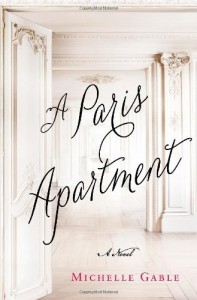 Remember THIS POST? Well readers I finally finished A Paris Apartment, a novel based on the life of Marthe de Florian and her forgotten apartment crammed with antiques and a famous portrait.
Remember THIS POST? Well readers I finally finished A Paris Apartment, a novel based on the life of Marthe de Florian and her forgotten apartment crammed with antiques and a famous portrait.
I admire any first time author who has the courage and fortitude to keep writing and get a novel (any novel) published, so it is with mixed feelings that I must tell you I tried to look at this debut from several different viewpoints, but there is no getting around my disappointment.
Perhaps I had unrealistically high expectations – what a great story could be told — the unopened apartment, the story behind the painting, Marthe and the time of the Belle Epoque*. Then contrast that with the modern-day story of the antiques experts who must have been agog at the opportunity to research the priceless antiques and delve into Marthe’s journals.
The actual Marthe started out as a bartender at the famous Les Folies Bergères, became an elegant courtesan known for having famous lovers, including a few prime ministers, a French president and the artist Boldini. Marthe left the apartment to her granddaughter, Madame de Florian, who shuttered the apartment and fled Paris at the start of WWII.
So, as you know from the previous post, I was seriously excited to open this book and settle in for a good read.
The chapters alternate between Marthe de Florian’s story told through fictionalized diary entries and April Vogt, a current-day American furniture expert from Sotheby’s who is called to Paris to help prepare the contents of the apartment for auction.
Marthe’s storyline was at times fascinating and the author (thankfully) took much from her actual life — how she created her name, her elegant persona and how she dug herself out of a brothel into high class society during the Bell Epoque. In contrast, the modern day story of April Vogt reads like poorly written chic-lit. I found my self slogging through April’s chapters and only somewhat enjoying Marthe’s.
There is some magical writing – the description of the famous chandelier at Les Folies Bergères is wonderful. The Paris setting(s) are beautifully and deliciously described. However, Ms. Gable stumbles in re-telling Marthe’s story, her diary entries seemed staged and she lets modern day language creep in. Sadly April is completely one-dimensional, so much so that this reader ended up disliking her character and her storyline was so predictable that I found myself imagining other outcomes. The novel borders on the raunchy and is written with such tactlessness that I cringed for the real Marthe de Florian. I found the ending almost ridiculous and in need of major editing – or perhaps, even completely deleted
Sigh — The Paris Apartment gets many 4 and 5 star reviews on both Goodreads and Amazon, so I am in the minority here. (Perhaps you’ll like this novel – go and seek it out if it interests you.)
Unfortunately, I wanted more — more richness, more depth, better writing – not this breezy and shallow version of what in reality must have been a fascinating story. The discovery of the forgotten apartment and its contents, the true life story of Marthe de Florian — they deserve a more intelligent telling
*Belle Epoque (Beautiful Era) was a period in the European history that is conventionally dated as starting in 1871 and ending when WWI began in 1914.








